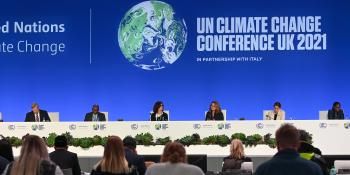How to navigate Spaceship Earth’s food security and land-based mitigation

A new article co-authored by Pete Smith and a global team of scientists poses one of the most pressing questions: How much land-based greenhouse gas mitigation can be achieved without compromising food security and environmental goals?
This is tough to answer. The authors’ first helpful contribution is to distinguish and quantify the range of options for action on the supply-side (improved management of biomass, soils, livestock, and energy use in agriculture and forestry) and the demand-side (reducing food waste, limiting over-consumption, and shifting to less resource-intense diets). But the potential global total for land-based mitigation is not a simple sum, as there are interactions and trade-offs among the different options. For example, less consumption of animal products will mean reduced methane emissions from livestock, but could also result in increased emissions from cropland. Modeling studies provide our best current means of navigating the various sets of options.
By pulling together modeling results and empirical science, the authors find that changes on the supply side, in agriculture and forestry, could offer emissions reductions of 1.5 to 4.3 Gt CO2 equivalent per year at carbon prices of between USD20 and USD100. To put that in perspective, the International Energy Agency estimated 2011 emissions as 31.6 Gt CO2 equivalent. The concept of “sustainable intensification" captures the principles behind achieving supply-side emissions reductions: essentially greater efficiency in turning limited inputs into useful outputs, in an equitable and ethical way.
Promisingly, demand-side measures could reduce emissions three to four times more than supply-side measures alone, anywhere between 1.5 and 15.6 Gt CO2 equivalent per year. Moreover, reduced food waste and less resource-intensive diets have guaranteed benefits for food security, compared to some supply-side options, such as biofuel production, that under some circumstances reduce food availability. In theory this is wonderful: coupling demand-side measures with sustainable intensification could, at maximum, cut away half of all global emissions at the 2011 level, even without any actions in transport, industry or other sectors.
Smith and co-authors wisely advocate that we take action simultaneously on supply-side and demand-side options. Policies can provide multiple incentives for land managers to intensify resource use sustainably and to spare land and biodiversity. A much more stubborn policy challenge is how to bring about appropriate changes in consumers’ behaviors. We need somehow to reduce waste and over-consumption of food without forcing massive price rises, or greater problems with food safety, onto the poorest and most undernourished consumers. It will take much political ingenuity to implement the smart technical solutions that we are beginning to recognize in Spaceship Earth’s operating manual.
Links
- Smith P, Haberl H, Popp A, Erb K-H, Lauk C, Harper R, Tubiello FN, de Siqueira Pinto A, Jafari M, Sohi S, Masera O, Böttcher H, Berndes G, Bustamante M, Ahammad H, Clark H, Dong H, Elsiddig EA, Mbow C, Ravindranath NH, Rice CW, Robledo Abad C, Romanovskaya A, Sperling F, Herrero M, House JI and Rose S. 2013. How much land-based greenhouse gas mitigation can be achieved without compromising food security and environmental goals? Global Change Biology 19: 2285–2302. doi: 10.1111/gcb.12160
- Global carbon-dioxide emissions increase by 1.0 Gt in 2011 to record high. http://www.iea.org/newsroomandevents/news/2012/may/name,27216,en.html
- Garnett T, Appleby MC, Blamford A, Bateman IJ, Benton TG, Bloomer P, Burlingame B, Dawkins M, Dolan L, Fraser D, Herrero M, Hoffmann I, Smith P, Thornton PK, Toulmin C, Vermeulen SJ and Godfray CJ. 2013. Sustainable intensification in agriculture: premises and policies. Science 341: 33-34. doi: 10.1126/science.1234485
This is the September 2013 edition of AgClim Letters, a regular analysis on science and policy written by Sonja Vermeulen, Head of Research for CCAFS. Sign up to receive AgClim Letters e-bulletin and read past editions. Your comments are welcome below.



